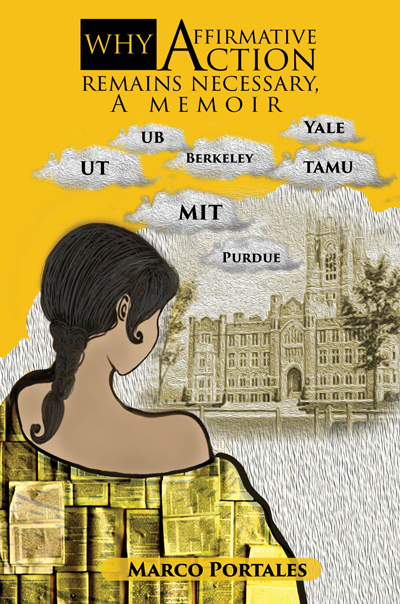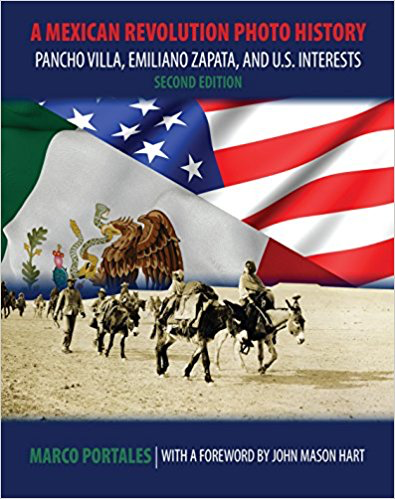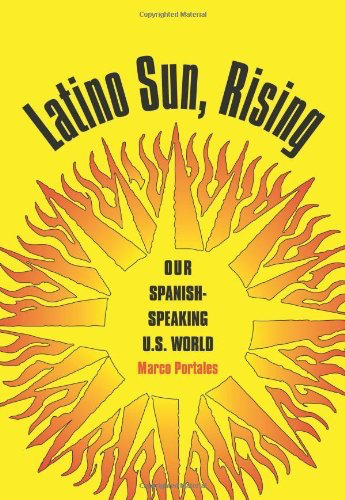5 Nonfiction Books & a Latino Novel: Media, History, Essays, and the Schools We Attend
My three-generation memoir, Why Affirmative Action Remains Necessary, blames the Supreme Court for ending the dreams of millions of people of color with its summer 2023 decision. The justices failed to understand that Affirmative Action allowed 58 years of minority success. DEI is no substitute.

Marco Portales, Bio
Why Affirmative Action Remains Necessary, a Memoir
The benefits of Affirmative Action become evident over the length of a person’s life. Before the Supreme Court nullified Affirmative Action, this 1965 law improved the economic standing of millions of people of color for 58 contentious years. Detractors always claimed it gave people of color a “free ride,” but we had to earn success. Success was not guaranteed.
WHY AFFIRMATIVE ACTION REMAINS NECESSARY compares Supreme Court Justice Clarence Thomas to Sonia Sotomayor, showing how Affirmative Action also changed my life. WHY AFFIRMATIVE ACTION REMAINS NECESSARY argues that the Supreme Court should have rejected the idea that “Affirmative Action is not needed anymore.” Why? Because this ruling disadvantages students of color and workers. It fails to encourage minority Americans to improve themselves, keeping countless disadvantaged individuals from college and work preparations that lead to better jobs and higher pay.Life quality improvements depend on opportunities. I describe how my brother Eddie and I found work as busboys in the downtown Loop of Chicago after dad’s death in 1969, followed by how the next summer I managed to became a mail carrier for an accounting firm in London, England.
Our immigrant parents raised us with the idea that our futures depended on a good college education. That is why I graduated from UT/Austin in 1970, after my Chicago summer job helped me move to Austin in 1968. Affirmative Action then allowed me to enroll in graduate school in New York state because Texas discouraged me. After two years in snowy Buffalo, I married a Puerto Rican bilingual teacher, earned a Ph.D. in English in 1974, and began life as a college professor.
In 44 short chapters, I describe how Eddie and I drove to Buffalo in 1970, before Rita and I began a new life in California’s Bay Area in 1974. There we raised a son and a daughter while Rita taught in the Oakland schools, and I worked to create a name for myself as a scholar and author on the UC/Berkeley campus.
Disadvantaged students and workers seeking improved employment will learn how I avoided being discouraged by bad situations and encounters, turning obstacles instead into advancements. Through patience, humor, and steady daily performance, this memoir shows how I succeeded.
WHY AFFIRMATIVE ACTION REMAINS NECESSARY shows readers with few resources and opportunities how to achieve your goals. It is a spirited memoir that promotes appreciation, understanding, and respect for the lives of our parents and the people around us while we pursue the dream that motivates us. This book was published in 2023 by Kindle Direct Publishing. (ISBN 979837643806)
Yearners, a novel about Texas Politics
This novel awaits discovery and promotion. YEARNERS shows how Latinos wait for political power in Texas–yearnings ironically strengthened when Trump ran for president in 2016. Instead of rejecting him, the GOP embraced his racism. Conservatives have continued to use GOP leadership positions and their superrich resources to derail the progress of people of color.
After Trump, there has been little incentive to support upwardly mobile minorities. Despite the advances Spanish-speakers have demonstrated during the last 50 years, politicians and the U.S. voting public are not helping people of color. The schools and universities are now rejecting all efforts that support Latino, African American, and Ethnic life and culture.
YEARNERS dramatizes why how quashing demographic diversity is Anti-American.
YEARNERS features Latinos who tolerate today’s realities by talking, yearning, and waiting for long overdue change. What else can people without power and leadership positions do? This novel shows how 6 bilingual males, 6 women, and 2 white individuals think, avoid violence, and excessive sex, countering the stories the media uses to make us look bad. While we yearn for better days, these characters bring out how U.S. life and culture engage Latinos.
YEARNERS avoids stereotypes, and offers readers a group of diverse Texans since 2002 when wealthy Tony Sanchez lost a campaign to unseat Rick Perry for Texas governor. The novel blueprints what the next Latino or Latina who runs for governor will face, highlighting the perspectives of different voting groups.
Employing today’s realities, YEARNERS shows the issues that separate American residents. Explore new possibilities with YEARNERS. Readers should know that YEARNERS was rejected by several backward Texas publishers, and published in 2017 in California by Floricanto Press. Here is the future of Texas, no kidding! (ISBN 9781540879189).
A Mexican Revolution Photo History
What do we know about the Mexican Revolution?
Do we know that the U.S. was intimately involved in a history that our schools fail to teach our children? Why do we remain ignorant of this part of American history?
History tells us that in 1846, ten years after the Alamo, President James K. Polk and Congress declared war on Mexico. The war with Mexico lasted two years, and deprived Mexico of 55 percent of its land, that is, Texas, New Mexico, Arizona, California, Colorado, and the southern parts of Nevada and Utah were ceded over to the U.S.! That Native American land grab further impoverished Mexico, a country long used to poverty and lacking public education and infrastructural amenities.
In the early 1860s, in an effort to gain possession of Mexico’s rich resources, France forced Mexico into yet another war, also to gain possession of Mexico’s rich resources. But this time Mexico surprisingly defeated France, and Porfirio Diaz emerged as a hero. Diaz then dominated our neighboring country, basically by allowing foreign governments to help him develop Mexico, for more than forty years.
After two failed attempts in 1906 and 1908, the poor peasants in Mexico, led by Pancho Villa from the north and Emiliano Zapata from southern Mexico, finally successfully revolted against Diaz in 1910. The Mexican Revolution lasted for THREE DECADES of the 20th century, with its repercussions still being felt by its people, the U.S., and the world today.
But how much of this part of our history do we know?
THE PROBLEM IS THAT EDUCATORS HAVE NEVER LEARNED THESE FACTS, SO THEY CANNOT TEACH A HISTORY THAT COULD IMPROVE OUR RELATIONS WITH MEXICO and Latin America. We constantly overlook North and South America!
Using original pictures taken by Mexican and international photographers, I narrate the causes behind the Mexican Revolution. Using public domain pictures and rare-book collections, I unearth some of the less-known reasons for the Revolution.
Did the U.S. presidents control the guns and the ammunition supplies that determined the outcomes of Mexico’s revolution? Instead of reproducing pictures of the revolution, like other photographic books, this picture history explains the alliances and deceptions, clarifying who did what to whom, when, and why events happened between 1906 and 1928. The result is a picture book full of revelations that amaze and educate readers! (I first published this photo history in 2010, before Kendall Hunt Publishing did in 2013. A Second Edition, with a Foreword by John Mason Hart, was published in 2015. You will not regret reading a book that will change your whole way of looking at history! (ISBN 9781465282040)
Latino Sun, Rising
Although Latinos comprise the largest group of minority Americans today, our cultural life resoundingly ignores this population. Though U.S. Spanish-speakers increasingly make up millions of the working, middle class, and future professionals, Americans pay us no attention.
In LATINO SUN, RISING, an English professor of American Literature and Ethnic Studies considers the recent past in light of historic and personal instances of resistance and success. In 44 hotly-debated essays not often addressed, Portales lays out the promise that a new rising sun has for Latinos and Latinas. These wake-up essays show how Latinos have worked to improve the United States, contributing to the success of all Americans, including neighbors who choose to misrepresent Latino progress!
In classes at UT/Austin, at SUNY/Buffalo, on the beaches of Corpus Christi, bussing tables in downtown Chicago, working by St. Paul’s Cathedral in London, teaching at UC/Berkeley, and while raising a family in Houston’s NASA area, Portales shows how his own journey and family life promote and celebrate the American Dream.
After featuring the World War II generation of his parents, he retraces the days of his happy youth during the Eisenhower years before unfurling the transformational ethnic consciousness that launched the sixties. LATINO SUN, RISING documents generational changes and advances personal and international stories that demonstrate why Latinos work to improve American life and culture. (Published in 2005 by the Texas A&M University Press, paperback edition in 2007; ISBN 9781585446377)
Quality Education for Latinos and Latinas
This University of Texas Press book reveals school inequities that DISADVANTAGED STUDENTS often face. It explains why U.S. Latinos and Latinas are less successful in school and later in life. It argues that educators who teach Spanish-speaking children from Pre-K through college consistently fail to challenge Latino children to do their best work.
Based on 35 years of careful observation of teaching methods in Texas, western New York state, and California, Rita and Marco Portales point out the educational realities that Latino children often endure.
While educators, legislators, and researchers debate how to improve American schools, the Portaleses show how the interactions between teachers and students–the most important school relationship–are often not applied to Latino children.
How a teacher interacts with each student in the classroom, from day one, determines whether a student will be properly prepared for higher education. Too many Latino, Latina, and students of color are often discouraged and dismissed by school interactions that should empower them. Facing teacher and administrative biases, social prejudices, racism, and other exclusionary practices, educators fail to create curricula that improve English-language skills. University education schools also ignore, dismiss, and downplay Latino student needs year after year.
QUALITY EDUCATION does not promote education theories and practices that change every 3 to 5 years, because educators are conducting “research.” Instead, this book asks parents, teachers, and administrators to work daily with students, both inside and outside of the classroom, to reduce cultural barriers. The objective is to help ALL students acquire a quality education by placing good teacher-student relations at the center of every student’s experience. Teachers and students need to learn from the start, every year, to respect each other, to avoid confrontations, and to work with the issues that students bring into the classroom from their home and neighborhood environments.
“A Print and Oral Approach” is featured on the skills that all students need from kindergarten through college. A quality education depends on excellent writing and oral communication skills, which often lead to the best adult jobs. When dedicated teachers prepare students as this book advises, all students will end as confident adults that employers seek, hire, and promote. (Published in 2005, cloth and paperback, by the UT Press;
ISBN 9780292706644)
Crowding Out Latinos
CROWDING OUT LATINOS shows how American culture has created a “public consciousness” about Latinos that assails them. U.S. Spanish-speakers are widely misrepresented. Despite efforts and honest pleas for inclusion, this book demonstrates how Latinos and Latinas are continually elbowed out by groups of Americans who refuse to help people of color.
Although Latinos comprise the largest population of minority Americans, this socio-cultural study examines how the American media and life work to disparage and immobilize Latinos. Mexican Americans are often represented by discouraging images, keeping Latinos and Latinas from advancing and succeeding. It is a tough reality to recognize, but it is the life under which too many Latinos daily labor.
CROWDING OUT LATINOS analyzes portrayals of Spanish-speakers in American popular culture, in Hollywood, and in our lives and workplaces in Texas, New York, California, and throughout the Southwest and the U.S.
By examining books written by famed Hollywood actor Anthony Quinn, Americo Paredes, Sandra Cisneros, and Ana Castillo, readers will see how Latinos have been historically diminished. Published 17 years before Trump publicly attacked Latinos and people of color, this turn-of-the-century nonfiction book shows why Americans and the world will benefit when Latinos are embraced, instead of being marginalized. (Published in Philadelphia in 2000 by Temple University Press in cloth and paperback;
ISBN 9781566397438)





